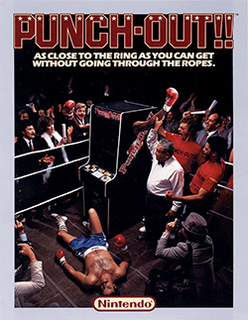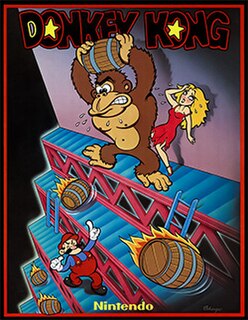
Nintendo Co., Ltd. is a Japanese multinational consumer electronics and video game company headquartered in Kyoto. The company was founded in 1889 as Nintendo Karuta by craftsman Fusajiro Yamauchi and originally produced handmade hanafuda playing cards. After venturing into various lines of business during the 1960s and acquiring a legal status as a public company under the current company name, Nintendo distributed its first video game console, the Color TV-Game, in 1977. It gained international recognition with the release of Donkey Kong in 1981 and the Nintendo Entertainment System and Super Mario Bros. in 1985.

The Nintendo 64 (abbreviated as N64, stylized as NINTENDO64) is a home video game console developed and marketed by Nintendo. The console is the successor to the Super Nintendo Entertainment System. It was first released on June 23, 1996 in Japan, on September 29, 1996 in North America, and March 1, 1997 in Europe and Australia. It was the last major home console to use cartridges as its primary storage format until the Nintendo Switch in 2017. As a fifth generation console, it competed primarily with the Sony PlayStation and the Sega Saturn.

The PlayStation is a home video game console developed and marketed by Sony Computer Entertainment. It was first released on 3 December 1994 in Japan, 9 September 1995 in North America, 29 September 1995 in Europe, and 15 November 1995 in Australia, and was the first of the PlayStation line of video game consoles. As a fifth-generation console, the original PlayStation primarily competed with the Nintendo 64 and the Sega Saturn.

The history of video games began in the 1950s and 1960s as computer scientists began designing simple games and simulations on mainframe computers, with MIT's Spacewar! in 1962 as one of the first such games to be played with a video display. The early 1970s brought the first consumer-ready video game hardware: the first home video game console, the Magnavox Odyssey, and the first arcade video games from Atari, Computer Space and Pong, the latter which was later made into a home console version. Numerous companies sprang up to capture Pong's success in both the arcade and the home by creating clones of the game, causing a market contraction in 1978 due to oversaturation and lack of innovation.
The video game crash of 1983 was a large-scale recession in the video game industry that occurred from 1983 to 1985, primarily in the United States. The crash was attributed to several factors, including market saturation in the number of game consoles and available games, as well as waning interest in console games in favor of personal computers. Revenues peaked at around $3.2 billion in 1983, then fell to around $100 million by 1985. The crash abruptly ended what is retrospectively considered the second generation of console video gaming in North America, as well as weakened the arcade game market.

Shigeru Miyamoto is a Japanese video game designer, producer and game director at Nintendo, where he serves as one of its representative directors. He is the creator of some of the most acclaimed and best-selling game franchises of all time, including Mario and The Legend of Zelda.

SNK Corporation is a Japanese video game hardware and software company. It is the successor to the company Shin Nihon Kikaku and presently owns the SNK video game brand and the Neo Geo video game platform. SNK's predecessor Shin Nihon Kikaku was founded in 1978 by Eikichi Kawasaki. The corporation was initially named Shin Nihon Kikaku. In 1981, the name was informally shortened to SNK Corporation, which became the company's official name in 1986.

Namco Limited was a Japanese multinational video game developer and publisher headquartered in Ōta, Tokyo. It held several international branches, including Namco America in Santa Clara, California, Namco Europe in London, Namco Taiwan in Kaohsiung, and Shanghai Namco in mainland China.
In the history of computer and video games, the third generation began on July 15, 1983, with the Japanese release of two systems: the Nintendo Family Computer and the Sega SG-1000. When the Famicom was released outside of Japan it was remodelled and marketed as the Nintendo Entertainment System (NES). This generation marked the end of the video game crash of 1983, and a shift in the dominance of home video game manufacturers from the United States to Japan. Handheld consoles were not a major part of this generation, although the Game & Watch line from Nintendo and the Milton Bradley Microvision were sold at the time. However, both are considered second generation hardware.
Masayuki Uemura is a Japanese professor and retired engineer and video game producer. A former employee of Sharp Corporation, he joined Nintendo in 1971 or 1972, working with Gunpei Yokoi and Genyo Takeda on solar cell technology for the Laser Clay Shooting System arcade game. After becoming General Manager of Nintendo R&D2, Uemura served as the lead architect for the Nintendo Entertainment System and Super NES game consoles. He retired from Nintendo in 2004 and is currently director for the Center for Game Studies at Ritsumeikan University.

Punch-Out!! is an arcade boxing video game by Nintendo, developed in 1983 and released in February 1984. It was the first in a series of successful Punch-Out!! games.

Donkey Kong is an arcade platform game announced by Nintendo in Japan on July 9, 1981, and released in mid-July 1981, then in North America later that month and Europe later that year. Its gameplay maneuvers Mario across platforms to ascend a construction site and rescue Pauline from the giant gorilla named Donkey Kong, all while avoiding or jumping over obstacles. It is the first game in both the Donkey Kong and Mario franchises.
Nintendo Entertainment Analysis & Development Division, commonly abbreviated as Nintendo EAD and formerly known as Nintendo Research & Development No.4 Department, was the largest software development division within the Japanese video game company Nintendo. It was preceded by the Creative Department, a team of designers with backgrounds in art responsible for many different tasks, to which Shigeru Miyamoto and Takashi Tezuka originally belonged. Both served as managers of the EARD studios and were credited in every game developed by the division, with varying degrees of involvement. Nintendo EAD was best known for its work on games in the Donkey Kong, Mario, The Legend of Zelda, F-Zero, Star Fox, Animal Crossing, Pikmin and Wii series.

Nintendo Research & Development No. 1 Department, commonly abbreviated as Nintendo R&D1, was Nintendo's oldest video game development team. It was known as Nintendo Research & Development Department before splitting in 1978. Its creation coincided with Nintendo's entry into the video game industry, and the original R&D1 was headed by Gunpei Yokoi. The developer has created several notable Nintendo series such as Metroid, Mario Bros., and Donkey Kong.
Sunsoft, stylized as SUNSOFT, is a Japanese video game developer and publisher.

Nintendo Integrated Research & Development Division, commonly abbreviated as Nintendo IRD, was a Japanese development division that handled everything related to producing Nintendo's console hardware and associated peripherals. Originally established in the 1970s with engineer Genyo Takeda acting as manager, Nintendo Research & Development No. 3 Department and part of the Manufacturing Division, the department was responsible for various hardware technologies and even developed several arcade and console titles. In 2000, as technology evolved into the 3D era, Takeda's group spun-off and established itself as a division into Integrated Research & Development Division, and began spending longer periods of time researching and testing the various and rapidly evolving hardware that would power Nintendo's next generation of consoles.
The history of Nintendo traces back to 1889, when it was founded to produce handmade hanafuda. Nintendo Co., Ltd. is a Japanese multinational consumer electronics company headquartered in Kyoto, Japan. It eventually became one of the most prominent figures in today's video game industry, being the world's largest video game company by revenue.

The Nintendo Entertainment System (NES) is an 8-bit third-generation home video game console produced by Nintendo. Nintendo first released it in Japan as the Family Computer (FC), commonly known as the Famicom, in 1983. The NES, a redesigned version, made its debut in test markets in the United States in October 1985, before becoming widely available in the rest of North America and other countries during the following years.

Sega Corporation is a Japanese multinational video game developer and publisher headquartered in Shinagawa, Tokyo. Its international branches, Sega of America and Sega Europe, are headquartered in Irvine, California, and London. Its division for both console and arcade video game development, Sega Games, has existed in its current state since 2020; from 2015 to that point, the two had made up separate entities known as Sega Games and Sega Interactive Co., Ltd.. Sega is a subsidiary of Sega Group Corporation, a part of Sega Sammy Holdings. From 1983 until 2001, Sega also developed video game consoles.
In the video game industry, a console war describes the competition between two or more video game console manufacturers in trying to achieve better consumer sales through more advanced console technology, an improved selection of video games, and general marketing around their consoles. While console manufacturers are generally always trying to out-perform other manufacturers in sales, these console wars engage in more direct tactics to compare their offerings directly against their competitors or to disparage the competition in contrast to their own, and thus the marketing efforts have tended to escalate in back-and-forth pushes.











